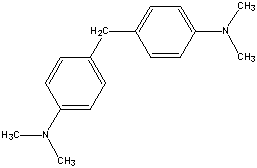
NTP Study Reports

NTP Study Reports
Home » Study Results & Research Projects » NTP Study Reports » All Long-Term Reports » Abstract for TR-186 - 4,4'-Methylenebis-(N,N-Dimethyl)Benzenamine

| Chemical Formula: C17 H22 N2 | - | 3D Structure* | |
|---|---|---|---|
| *To view structure, download free Chemscape Chime Plug-in | |||
4,4'-Methylenebis(N,N-dimethyl)benzeneamine, a bicyclic aromatic amine and an intermediate in dye manufacture, was selected for bioassay by the National Cancer Institute because of a high incidence of bladder cancer observed among dye manufacturing industry workers.
A bioassay for the possible carcinogenicity of 4,4'-methylenebis-(N,N-dimethyl)benzeneamine was conducted using Fisher 344 rats and B6C3F1 mice. 4,4'-Methylenebis-(N,N-dimethyl)benzeneamine was administered in the feed, at either of two concentrations, to groups of 50 male and 50 female animals of each species. Twenty animals of each sex and species were placed on test as controls. The high and low dietary concentrations of 4,4'-methylenebis-(N,N-dimethyl)benzeneamine were, respectively, 750 and 375 ppm for rats and 2500 and 1250 ppm for mice. The compound was administered for 59 weeks to rats and for 78 weeks to mice. The period of compound administration was followed by an observation period of 45 weeks for rats and 13 weeks for mice.
There were no significantly positive associations between the concentrations of 4,4'-methylenebis-(N,N-dimethyl)benzeneamine administered and mortality among rats or mice of either sex. Adequate numbers of animals survived sufficiently long to be at risk from late-developing tumors. There was slight dose-related mean body weight depression among female rats, the mean body weight of high dose male rats was slightly less than that for controls, and the mean body weights of dosed mice were significantly lower than their controls, indicating that the concentrations of 4,4'-methylenebis-(N,N-dimethyl)benzeneamine administered to these animals in this bioassay may have approximated the maximum tolerated concentrations.
For both male and female rats, there was a significant positive association between the concentrations of 4,4'-methylenebis-(N,N-dimethyl)benzeneamine administered and the incidences of follicular-cell carcinomas of the thyroid (i.e., 1/18, 4/50, and 21/46 in the control, low dose, and high dose males, respectively; and 0/20, 3/46, and 23/45 in the control, low dose, and high dose females, respectively). The high dose to control Fisher exact comparisons were also significant for each sex.
Liver neoplasms were observed among male and female mice. There were elevated incidences of hepatocellular adenomas in dosed mice when compared to controls (i.e., 2/20, 3/50, and 16/48 in control, low dose, and high dose males, respectively; and 1/19, 18/49, and 22/48 in control, low dose, and high dose females). The incidences of hepatocellular carcinomas in dosed mice did not differ greatly from those in controls (i.e., 3/20, 9/50, and 6/48 in control, low dose, and high dose males, respectively; and 0/19, 1/49, and 1/48 in control, low dose, and high dose females). Among both sexes of mice, there was a significant positive association between the concentrations of the chemical administered and the incidences of a combination of hepatocellular adenomas and hepatocellular carcinomas. For male mice, the Fisher exact comparisons were not significant; however, for females, both the high dose to control and the low dose to control comparisons were significant.
In both sexes of both species nonneoplastic proliferative lesions of the thyroid occurred in dosed animals but not in any of the controls.
Under the conditions of this bioassay, 4,4'-methylenebis-(N,N-dimethyl)benzeneamine was carcinogenic in Fisher 344 rats, inducing thyroid follicular-cell carcinomas in both males and females. Administration of the compound was carcinogenic in female B6C3F1 mice, inducing liver neoplasms. There was no conclusive evidence that 4,4'-methylenebis-(N,N-dimethyl)benzeneamine was carcinogenic in male B6C3F1 mice.
Levels of Evidence of Carcinogenicity: | ||
| Male Rats: | Positive | |
| Female Rats: | Positive | |
| Male Mice: | Equivocal | |
| Female Mice: | Positive | |
Synonyms: 4,4'-methylenebis(N,N-dimethyl)aniline; tetramethyldiaminodiphenylmethane; 4,4'-bis(dimethylamino) diphenylmethane; Tetra base; Methane base; Michler's base; Michler's hydride; Michler's methane
Report Date: 1979
Target Organs from 2-year Studies
You may link to the full technical report in pdf format ( Note: A print ready copy of the document is presented in Portable Document Format (pdf) which requires the Acrobat Reader plug-in -- download a free copy of the reader.)
Web page last updated on October 14, 2004
The National Institute of Environmental Health Sciences is one of the National Institutes of Health within the U.S. Department of Health and Human Services. The National Toxicology Program is headquartered on the NIEHS campus in Research Triangle Park, NC.